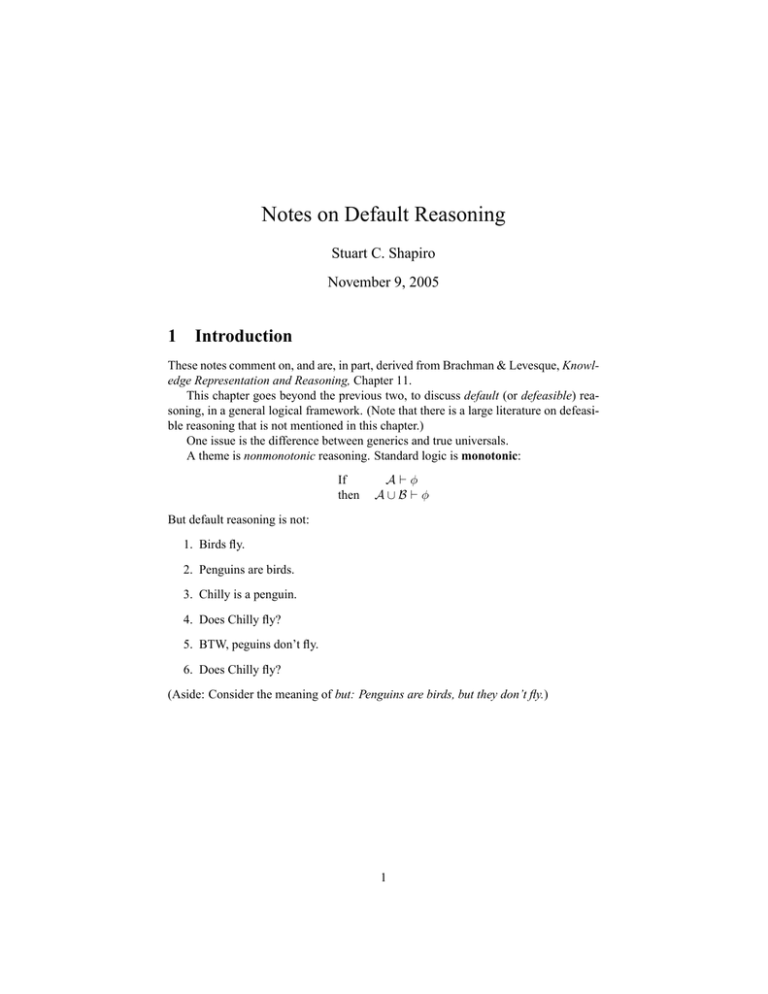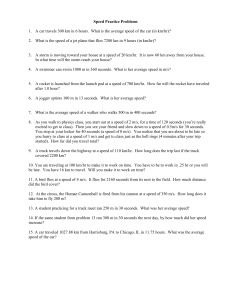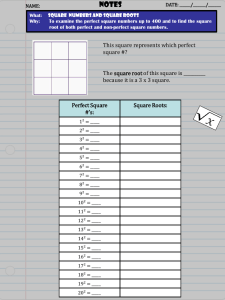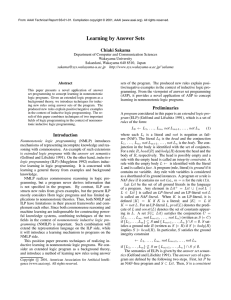Notes on Default Reasoning 1 Introduction Stuart C. Shapiro
advertisement

Notes on Default Reasoning
Stuart C. Shapiro
November 9, 2005
1
Introduction
These notes comment on, and are, in part, derived from Brachman & Levesque, Knowledge Representation and Reasoning, Chapter 11.
This chapter goes beyond the previous two, to discuss default (or defeasible) reasoning, in a general logical framework. (Note that there is a large literature on defeasible reasoning that is not mentioned in this chapter.)
One issue is the difference between generics and true universals.
A theme is nonmonotonic reasoning. Standard logic is monotonic:
If
then
A`φ
A∪B `φ
But default reasoning is not:
1. Birds fly.
2. Penguins are birds.
3. Chilly is a penguin.
4. Does Chilly fly?
5. BTW, peguins don’t fly.
6. Does Chilly fly?
(Aside: Consider the meaning of but: Penguins are birds, but they don’t fly.)
1
2
Closed-World Reasoning
Incorporate the Closed-World Assumption (CWA) into the standard approach by defining
KB |=C α iff KB+ |= α, where
KB+ = KB ∪ {¬p | p is atomic and KB 6|= p}
Problem: if KB = {(p∨q)}, then KB+ contains {(p∨q), ¬p, ¬q}, and is inconsistent.
Solution: generalized closed-world assumption (GCWA)
KB |=GC α iff KB∗ |= α, where
KB∗ = KB ∪ {¬p | for all collections of atoms q1 , . . . , qn ,
if KB |= (p ∨ q1 ∨ . . . ∨ qn ), then KB |= (q1 ∨ . . . ∨ qn )}
I.e., it’s one of the q’s that is true.
So, if KB = {(p ∨ q)}, then ¬p 6∈ KB∗ and ¬q 6∈ KB∗ , but ¬r ∈ KB∗ .
Example: In Clue, Tom is asked if he has Miss Scarlett, the Kitchen, or the knife, and
shows one card. Later, he’s asked if he has Prof. Plum, the Kitchen, or the knife, and
shows one card. However, you have Prof. Plum. GCWA allows you to conclude, by
default, that Tom doesn’t have Miss Scarlett.
2
Domain Closure: What does {¬p | p is atomic} include? Form all atomic sentences
by giving every predicate symbol every possible combination of arguments. It’s a finite
collection as long as there’s no function symbol. (The text says even then, but I don’t
think so.) Consider a KB with: no quantified formulas; one unary predicate, P ; one
binary predicate, R; two individual constants, a, b; one individual constant, c, such that
KB has P (c), but c doesn’t occur as either argument of R.
{¬p | p is atomic}, and therefore KB+ , includes
{¬R(a, c), ¬R(c, a), ¬R(b, c), ¬R(c, b), ¬R(c, c)}
However, KB+ 6|= ¬∃xR(x, c) if you assume there could be some individual other
than a, b, or c, i.e. an unnamed individual.
This raises the issue of how semantics is done:
1. (The way I like): [[∃xR(x, c)]] is True if there is some ground term, t such that
[[R(t, c)]] is True; otherwise, it is False. By this, KB+ |= ¬∃xR(x, c).
2. (The usual way): [[∃xR(x, c)]] is True if there is some individual i in the domain
such that hi, [[c]]i ∈ [[R]]; otherwise, it is False. By this, there might be no ground
term denoting i, and KB+ 6|= ¬∃xR(x, c).
Closed-world assumption with domain closure uses (2), but uses:
KB |=CD α iff KB |= α, where
KB = KB+ ∪ {∀x[x = c1 ∨ . . . ∨ cn ]}
where c1 , . . . , cn are all the individual constants in KB.
So KB |= ¬∃xR(x, c), even using semantics version (2). Moreover,
KB |=CD ∀xα iff KB |=CD α{c/x}, for every c appearing in KB;
KB |=CD ∃xα iff KB |=CD α{c/x}, for some c appearing in KB;
Notice that the domain closure axiom means that every individual in the domain has an
individual constant that denotes it. In fact, if the KB includes function symbols, then,
by the domain closure axiom, every functional term is also equal to some individual
constant. This is more restrictive than what I use for semantics, which is just the
assumption that every individual is denoted by some ground term.
The text’s ultimate KB for CWA is KB with the further addition of the unique
name assumption, that c1 6= c2 for every pair of distinct individual constants, c1 and
c2 .
With this version of KB , KB |=CD α or KB |=CD ¬α for any formula, α.
3
Warning: Still, I may need to modify my approach, and KB may be inconsistent.
Consider KB = P (a) ∧ (∀x¬R(x, x)) ∧ (∃xR(x, a)). This is only consistent if there is
an “unnamed” individual—one other than [[a]].
In fact, one can require an infinite number of individuals with
N (a)∧(∀xB(x, f (x)))∧(∀x, y, z(B(x, y)∧B(y, z) ⇒ B(x, z)))∧(∀x, yB(x, y) ⇔ ¬B(y, x))
and this would make the domain closure axiom inconsistent. The text says
But these examples are somewhat far-fetched; they look more like formulas that might appear in axiomatizations of set theory than in databases.
For “normal” applications, domain closure is much less of a problem.
[B&L, p. 215, italics added]
But what about KBs that include ∀x[Duck(motherOf (x)) ⇒ Duck(x)]
or ∀p[Believe(p) ⇒ Believe(Believe(p))]? These require an infinite number of
individuals, and seem useful for commonsense reasoning.
[Modification of my approach: Add constants and function symbols as would be
required when Skolemizing all formulas in the KB.]
3
3.1
Circumscription
Idea 1: Circumscribing Predicates
Can view CWA as minimizing the extension of all predicates. I.e. P (a) is True only
where it has to be; for all other individuals, b, ¬P (b).
In circumscription, we minimize (circumscribe) the extension of selected predicates.
3.2
Idea 2: Ab
We can’t say ∀x [Bird (x ) ⇒ Flies(x )], because there are birds that don’t fly for various
reasons: they’re penguins, they’re emus, they’re immature, they’re dead, etc. We could
think of doing
∀x [Bird (x ) ∧ ¬Penguin(x ) ∧ ¬Emu(x ) ∧ ¬Immature(x ) ∧ ¬Dead (x ) ⇒ Flies(x )]
but whenever we come upon a new exceptional class, we’d have to delete this rule, and
replace it with a more inclusive one. Instead, once and for all state
∀x [Bird (x ) ∧ ¬AbFlies (x ) ⇒ Flies(x )]
and then for each exceptional case, add
∀xPenguin(x ) ⇒ AbFlies (x )
∀xEmu(x ) ⇒ AbFlies (x )
∀xImmature(x ) ⇒ AbFlies (x )
∀xDead (x ) ⇒ AbFlies (x )
etc.
4
3.3
Together
So say we’ve done that, and have
Bird(chilly), Bird(tweety), (tweety 6= chilly), P engin(chilly)
Can we conclude Flies(tweety)? No! Because can’t infer ¬AbFlies (tweety).
So circumscribe AbFlies .
3.4
Minimal Entailment
KB |=≤ α iff every interpretation (situation) that satisfies KB and minimizes the extension of each Ab predicate also satisfies α.
Above KB |=≤ Flies(tweety) because every interpretation that satisfies the KB and
minimizes AbFlies also satisfies ¬AbFlies (tweety) and therefore also satisfies Flies(tweety).
3.5
Problems
Sections 11.3.2 and 11.3.3 of the text suggest additional modifications of circumscription. Unfortunately, it all ends with “there is a serious limitation in using circumscription for default reasoning” [B & L, p. 222].
5
4
Default Logic
The general problem we’re considering is that generic statements may have exceptions—
they’re not actually strict universals. The Default Logic approach is to represent strict
universals in the usual Predicate Logic way, but to represent generic statements as a
special kind of default rule.
A default rule is of the form α:β
δ , and may be glossed as “If α is true and β is
consistent, then conclude δ.”
Default rules are not sentences of the object language. That is, a default rule cannot
be a subexpression of another expression. A default rule, instead, is like a rule of
inference of Predicate Logic.
A KB using default logic has two parts
1. A set F of sentences of Predicate Logic.
2. A set D of default rules.
If you view F as a set of beliefs that can increase as reasoning is performed, then
you can add to F any belief that is logically implied (according to the usual rules of
inference) by the beliefs already in F, and in addition, any belief that is justified by any
of the default rules in D. More formally, a set of beliefs implied by a default theory
KB = (F, D) is an extension E such that
π ∈ E iff F ∪ {δ |
α:β
∈ D, α ∈ E, ¬β 6∈ E} |= π
δ
Example:
F = {Bird(T weety), P enguin(Chilly),
∀x[P enguin(x) ⇒ Bird(x)], ∀x[P enguin(x) ⇒ ¬F lies(x)]}
lies(x)
D = { Bird(x):F
}
F lies(x)
F lies(T weety) may be inferred, but not F lies(Chilly).
Although, in general, in default rules, α:β
δ , β need have no syntactic relation to δ,
the most useful default rules are normal default rules, where β is the same as δ. Normal
default rules also avoid the problematic T rue:p
¬p .
What if we allow for flying penguins? Such a default KB might look like:
F = {Bird(T weety), P enguin(Chilly), ∀x[P enguin(x) ⇒ Bird(x)]}
lies(x) P enguin(x):¬F lies(x)
D = { Bird(x):F
,
}
F lies(x)
¬F lies(x)
We may conclude that Chilly flies or not, depending on which default rule is used (first).
Thus, we are again in the realm of multiple extensions, and can consider credulous
reasoners vs. skeptical reasoners.
enguin(x)
We could try to patch the first default rule, and replace it with Bird(x):F lies(x)∧¬P
F lies(x)
Now we are back to the problem that circumscription was designed to deal with, so
F lies (x)
F lies (x)
how about Bird(x):F lies(x)∧¬Ab
and T rue:¬Ab
? Would you then add
F lies(x)
¬AbF lies (x)
P enguin(x):AbF lies (x)
?
AbF lies (x)
6
5
Autoepistemic Logic
Put default rules into the object language by introducing a modal, or higher-level, operator B, where the meaning of Bα is “α is believed.” Then the default flying rule
becomes ∀x [Bird (x ) ∧ ¬B¬Flies(x ) ⇒ Flies(x )].
Now a set of beliefs justified by an autoepistemic KB is a stable extension, E such
that
π ∈ E iff KB ∪ {Bα | α ∈ E} ∪ {¬Bα | α 6∈ E} |= π
E has three significant properties:
1. Closure under entailment: if E |= α then α ∈ E.
2. Positive introspection: if α ∈ E then Bα ∈ E
3. Negative introspection: if α 6∈ E then ¬Bα ∈ E
Question: Are these cognitively reasonable?
6
Conclusion
B&L conclude, “Getting a logical account of default reasoning that is simple, broadly
applicable, and intuitively correct remains an open problem...it is perhaps the open
problem in the whole area of knowledge representation.” [p. 232–3]
7






